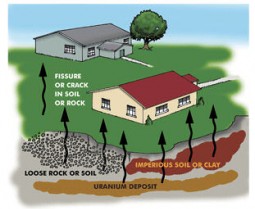Radon
What is Radon?
Radon is a naturally occurring radioactive gas formed from the radioactive decay of Uranium found in rocks and soil under the home. Radon gas rises or is drawn through loose gravel, cracks, and underground fissures finding its way into homes and buildings. Whenever the air pressure inside a building is lower than the air pressure outside the building (it usually is) a vacuum is created. This draws radon gas through concrete pores, cracks and any other openings in the foundation. Elevated Radon levels and long term exposure in a home or building are considered health hazards.
Since radon is the second leading cause of lung cancer and lung cancer causes more cancer deaths than any other, it makes sense to test for radon. Frequently, a seller covers the cost of mitigation (repair) if a high level is found.
In Illinois, a seller must disclose (or face a $5000 penalty) if a radon test came in high and was not professionally corrected. If a seller will not correct a high level, be sure to include the radon mitigation cost as part of your home purchase. High levels of radon can be repaired in any home.
Where Has Radon Been Found?
Radon can exist virtually anywhere, even in the Chicago area. Sometimes you will have it and your neighbor won't.
Has Radon been found near here?
High Radon levels have been found in more than 40% of the homes in this part of Illinois. Frequently, one home will have a high level and neighboring homes won't.
Detecting Radon:
There are many ways testing can be performed: E-Perm Ionization Chambers, Self-Test kits, and Continuous Radon Monitors. The “do it yourself” test kits require the devices be sent to a laboratory to analyze the results and wait for the report to come back. This process will add too many days to the testing process. The results obtained by unlicensed testing persons are not acceptable in a Real Estate transaction.
The first step is to test your home for radon, and have it corrected if it is at or above EPA's Action Level of 4 pico-Curies per liter. Even the “SAFE” (acceptable?) radon level is equivalent to the radiation from more than 100 chest X-rays each year!
What can I do to protect myself and my family from radon?
The first step is to test your home for radon, and have it fixed if it is at or above EPA's Action Level of 4 pico-Curies per liter. That's equivalent to 200 chest X-rays each year! .Because the level of radioactivity is directly related to the number and type of radioactive atoms present, radon and all other radioactive atoms are measured in pico-Curies. For instance, a house having 4 pico-Curies of radon per liter of air (4 pCi/L) has about 8 or 9 atoms of radon decaying every minute in every liter of air inside the house. A 1,000-square-foot house with 4 pCi/L of radon has nearly 2 million radon atoms decaying in it every minute. Generally, levels can be brought below 2 pCi/l fairly simply.
The best method for reducing radon in your home will depend on how radon enters your home and the design of your home. For example, sealing cracks in floors and walls may help to reduce radon. There are also systems that remove radon from the crawl space or from beneath the concrete floor or basement slab that are effective at keeping radon from entering your home. These systems are simple and don't require major changes to your home. Other methods may be necessary.People who have private wells should test their well water to ensure that radon levels meet EPA's newly proposed standard.
Detecting Radon
There are many ways testing can be performed: E-Perm Ionization Chambers, Self-Test kits, and Continuous Radon Monitors. The “do it yourself” test kits require the devices be sent to a laboratory to analyze the results and wait for the report to come back. This process will add too many days to the testing process. The results obtained by unlicensed testing persons are not acceptable in a Real Estate transaction.
The first step is to test your home for radon, and have it corrected if it is at or above EPA's Action Level of 4 pico-Curies per liter. Even the “SAFE” (acceptable?) radon level is equivalent to the radiation from more than 100 chest X-rays each year!
The testing process
One or more devices are placed in the home for a period of at least 48 hours under prescribed conditions. I have found that even some licensed radon testers do not follow the strict IEMA license testing requirements when performing radon testing. This can skew test results and may give a false high or low reading. Price of testing does not always appear to reflect quality.
And if the Radon level comes in high…
Most of the homes in this area are corrected using sub slab depressurization at a cost of about $700 to $1500. Only licensed mitigators can install these systems. They are quiet, cost as much to operate as a 40 watt light bulb, and typically require service only about every 7 to 10 years.
What is the cost of a radon test?
I offer Radon testing utilizing only experienced, prescreened, state licensed individuals for $195.
